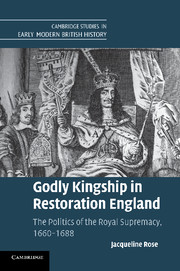Book contents
- Frontmatter
- Contents
- Acknowledgements
- Abbreviations and conventions
- Introduction The Restoration, the Reformation, and the royal supremacy
- Chapter 1 Foundations and legacies: the Reformation and the royal supremacies, 1530–1660
- Chapter 2 The crown and the cavalier Anglicans: prerogative, parliament, and ecclesiastical law
- Chapter 3 Spiritual authority and royal jurisdiction: the question of bishops
- Chapter 4 Dissenters and the supremacy: the question of toleration
- Chapter 5 Anticlericals and ‘Erastians’: the spectre of Hobbes
- Chapter 6 Catholics and Anglicans: James II and Catholic supremacy
- Conclusion
- Bibliography
- Index
- References
Chapter 6 - Catholics and Anglicans: James II and Catholic supremacy
Published online by Cambridge University Press: 05 July 2011
- Frontmatter
- Contents
- Acknowledgements
- Abbreviations and conventions
- Introduction The Restoration, the Reformation, and the royal supremacy
- Chapter 1 Foundations and legacies: the Reformation and the royal supremacies, 1530–1660
- Chapter 2 The crown and the cavalier Anglicans: prerogative, parliament, and ecclesiastical law
- Chapter 3 Spiritual authority and royal jurisdiction: the question of bishops
- Chapter 4 Dissenters and the supremacy: the question of toleration
- Chapter 5 Anticlericals and ‘Erastians’: the spectre of Hobbes
- Chapter 6 Catholics and Anglicans: James II and Catholic supremacy
- Conclusion
- Bibliography
- Index
- References
Summary
To be a Catholic in seventeenth-century England was to court opprobrium, social exclusion, and political suspicion. While in practice Englishmen co-existed with their Catholic neighbours, they feared and reviled the vaguer bogeyman of the papist. The spectre of popery haunted British kings and it twice derailed Stuart monarchs, in the mid-century Civil Wars and in the Revolution of 1688. If Charles I had lost his kingdoms because he was thought to have countenanced creeping crypto-Catholicism at court, and Charles II had been rocked by the Exclusion Crisis partly over fears of a popish successor, what chance did a dedicated overtly Catholic king have? James’s vow upon his accession to ‘preserve the government in Church and State as it is by law established’ might have provided limited reassurance when the nation called to mind similar early promises by the previous Catholic monarch, Mary I. From the incense burned at the Mass which James attended nine days after his accession Protestant nostrils imbibed no holy aroma, but rather the acrid whiff of Smithfield flames.
- Type
- Chapter
- Information
- Godly Kingship in Restoration EnglandThe Politics of The Royal Supremacy, 1660–1688, pp. 229 - 274Publisher: Cambridge University PressPrint publication year: 2011

